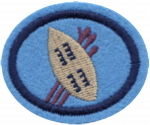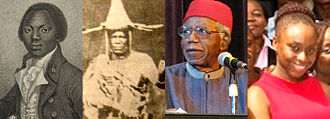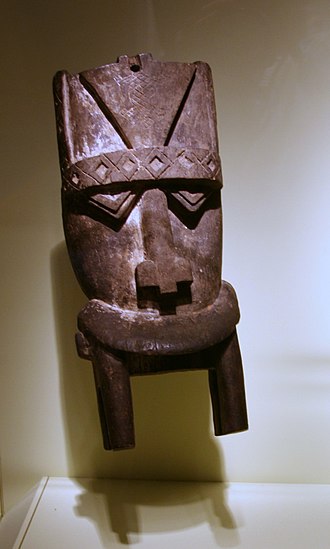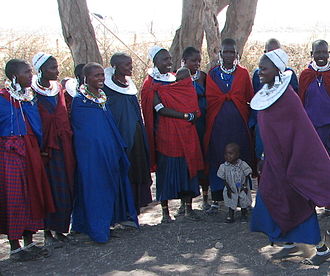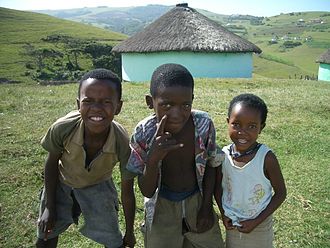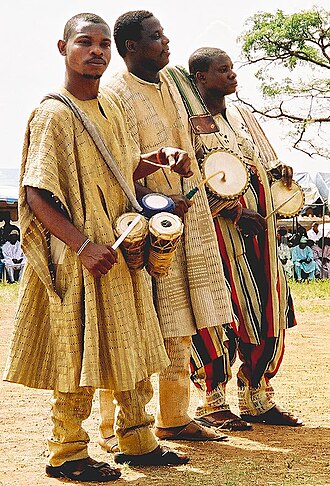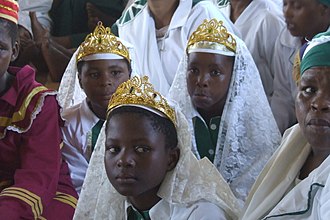Especialidades JA/Tradición africana/Respuestas
| Folclore Africano | ||
|---|---|---|
| Asociación General
|
Destreza: 1 Año de introducción: 2001 |
|
Requisitos
1. Ser capaz de nombrar y localizar al menos 10 diferentes tribus africanas de la actualidad y decir varias características de cada una.
2. Hacer lo siguiente:
a. Seleccionar una tribu africana para el estudio. Si usted pertenece a una tribu africana, seleccionar una que no sea la suya.
b. Encontrar información detallada sobre las tribus seleccionadas, en las siguientes áreas:
i. Los hábitos alimenticios
ii. Ceremonia de iniciación
iii. Médicos tradicionales y yerbateros
iv. Condiciones de vida y cultos
v. Educación��
=vi. Entierros
vii. Dinero
iix. Vestido
ix. Industria
|Members=Over 6 million }}
Igbo
| Igbo |
|---|
|
Hábitos alimenticios: The yam is very important to the Igbo as it is their staple crop. There are celebrations such as the New yam festival which are held for the harvesting of the yam. During the festival yam is eaten throughout the communities as celebration. Yam tubers are shown off by individuals as a sign of success and wealth. Rice has replaced yam for ceremonial occasions. Other foods include cassava, garri, maize and plantains. Soups or stews are included in a typical meal, prepared with a vegetable (such as okra, of which the word derives from the Igbo language, Okwuru) to which pieces of fish, chicken, beef, or goat meat are added. Jollof rice is popular throughout West Africa. The Igbo believe in reincarnation. People are believed to reincarnate into families that they were part of while alive. Before a relative dies, it is said that the soon to be deceased relative sometimes give clues of who they will reincarnate as in the family. Once a child is born, he or she is believed to give signs of who they have reincarnated from. This can be through behavior, physical traits and statements by the child. A diviner can help in detecting who the child has reincarnated from. Dinero: File:Stamp Nigeria 1953 0.5p manilla.jpg A Stamp depicting Manillas Manillas are ring-like armlets, mostly in bronze or copper, very rarely gold, which served as a form of money or barter coinage and to a degree, ornamentation, amongst certain West African peoples including the Igbo. They also became known as "slave trade money" after the Europeans started using them to acquire slaves for the slave trade into the Americas (as well as England prior to 1807). Women traditionally carry their babies on their backs with a strip of clothing binding the two with a knot at her chest, a practice used by many ethnic groups across Africa. This method has been modernized in the form of the child carrier. In most cases Igbo women did not cover their breast areas. Maidens usually wore a short wrapper with beads around their waist and other ornaments such as necklaces and beads. Both men and women wore wrappers. Men would wear loin cloths that wrapped round their waist and between their legs to be fastened at their back, the type of clothing appropriate for the intense heat as well as jobs such as farming. In the same era as the rise of colonial forces in Nigeria, the way the Igbo dressed changed. These changes made the Igbo adopt Westernized clothing such as shirts and trousers. Clothing worn before colonialism became "traditional" and worn on special occasions. The traditional clothing itself became westernized with the introduction of various types of Western clothing including shoes, hats, trousers, etc. Modern Igbo traditional attire, for men, is generally made up of the Isiagu top which resembles the Dashiki worn by other African groups. Isiagu (or Ishi agu) is usually patterned with lions heads embroidered over the clothing and can be a plain color. It is worn with trousers and can be worn with either a traditional title holders hat or with the traditional Igbo stripped men's hat. For women, a puffed sleeve blouse (influenced by European attire) along with two wrappers and a head tie are worn. Miembros: Between 24 and 25 million |
Ijaw
| Ijaw |
|---|
|
Hábitos alimenticios: Like many ethnic groups in Nigeria, the Ijaws have many local foods that are not widespread in Nigeria. Many of these foods involve fish and other seafoods such as clams, oysters and periwinkles; yams and plantains. Some of these foods are:
|
Maasai
| Maasai |
|---|
|
Hábitos alimenticios: Traditionally, the Maasai diet consisted of meat, milk, and blood from cattle. An ILCA study (Nestel 1989) states: “Today, the staple diet of the Maasai consists of cow's milk and maize-meal. The former is largely drunk fresh or in sweet tea and the latter is used to make a liquid or solid porridge. The solid porridge is known as uoali and is eaten with milk; unlike the liquid porridge, uoali is not prepared with milk. Meat, although an important food, is consumed irregularly and cannot be classified as a staple food. Animal fats or butter are used in cooking, primarily of porridge, maize, and beans. Butter is also an important infant food. Blood is rarely drunk.” During this period, the newly circumcised young men will live in a "manyatta", a "village" built by their mothers. The manyatta has no encircling barricade for protection, emphasizing the warrior role of protecting the community. No inner krall is built, since warriors neither own cattle or undertake stock duties. Further rites of passage are required before achieving the status of senior warrior, culminating in the eunoto ceremony, the "coming of age". Educación: Zimbabwe has an adult literacy rate of approximately 90% which is amongst the highest in Africa. Since 1995 the adult literacy rate of Zimbabwe has steadily decreased, a trend shared by other African countries. The wealthier portion of the population usually send their children to independent schools as opposed to the government-run schools which are attended by the majority as these are subsidised by the government. School education was made free in 1980, but since 1988, the government has steadily increased the charges attached to school enrollment until they now greatly exceed the real value of fees in 1980. The Ministry of Education of Zimbabwe maintains and operates the government schools but the fees charged by independent schools are regulated by the cabinet of Zimbabwe. Zimbabwe's education system consists of 7 years of primary and 6 years of secondary schooling before students can enter university in the country or abroad. The academic year in Zimbabwe runs from January to December, with three month terms, broken up by one month holidays, with a total of 40 weeks of school per year. National examinations are written during the third term in November, with "O" level and "A" level subjects also offered in June. If a person initiates the burial of a person of a different totem, he runs the risk of being asked to pay a fine to the family of the deceased. Such fines traditionally were paid with cattle or goats but nowadays substantial amounts of money can be asked for. Vestimenta: Today the Shona dress in western clothing. In the 19th century the men wore breech clothes of animal hide. |
Tuareg
| Tuareg |
|---|
|
Hábitos alimenticios: The Tuareg diet consists mostly of grains supplemented with fruits such as dates and melons (when in season), and milk and cheese. Meat is reserved for special occasions.
Religión: The Tuareg are predominantly Muslim and generally follow the Maliki madhhab, one of the four schools of Fiqh or religious law within Sunni Islam. |
Xhosa
| Xhosa |
|---|
|
Hábitos alimenticios: The Xhosa settled on mountain slopes of the Amatola and the Winterberg Mountains. Many streams drain into great rivers of this Xhosa territory including the Kei and Fish Rivers. Rich soils and plentiful rainfall make the river basins good for farming and grazing making cattle important and the basis of wealth. Traditional foods include beef (Inyama yenkomo), mutton (Inyama yegusha), and goat meat, sorghum, maize and dry maize porridge (umphokoqo), "umngqusho" (made from dried, stamped corn and dried beans), milk (often fermented, called amasi), pumpkins (amathanga), beans (iimbotyi), and vegetables. The Xhosas have a strong oral tradition with many stories of ancestral heroes; according to tradition, the leader from whose name the Xhosa people take their name was the first human on Earth. Other traditions have it that all Xhosas are descended from one ancestor named Tshawe. The key figure in the Xhosa oral tradition is the imbongi (plural: iimbongi) or praise singer. Iimbongi traditionally live close to the chief's "great place" (the cultural and political focus of his activity); they accompany the chief on important occasions - the imbongi Zolani Mkiva preceded Nelson Mandela at his Presidential inauguration in 1994. Iimbongis' poetry, called imibongo, praises the actions and adventures of chiefs and ancestors. Christian missionaries established outposts among the Xhosa in the 1820s, and the first Bible translation was in the mid-1850s, partially done by Henry Hare Dugmore. Xhosa did not convert in great numbers until the 1900s, but now many are Christian, particularly within the African Initiated Churches such as the Zion Christian Church. Some denominations combine Christianity with traditional beliefs. |
Yoruba
| Yoruba |
|---|
|
The popularly known Vodou religion of Haiti combines the religious beliefs of the many different African ethnic nationalities taken to the island with the structure and liturgy from the Fon-Ewe of present-day Benin and the Congo-Angolan culture area, but Yoruba-derived religious ideology and deities also play an important role. Yoruba deities include "Ọya" (wind/storm), "Ifá" (divination or fate), "Ẹlẹda" (destiny), Orisha or Orisa "Ibeji" (twin), "Ọsanyin" (medicines and healing) and "Ọsun" (goddess of fertility, protector of children and mothers), Sango (God of thunder). Human beings and other sentient creatures are also assumed to have their own individual deity of destiny, called "Ori", who is venerated through a sculpture symbolically decorated with cowrie shells. Traditionally, dead parents and other ancestors are also believed to possess powers of protection over their descendants. This belief is expressed in veneration and sacrifice on the grave or symbol of the ancestor, or as a community in the observance of the Egungun festival where the ancestors are represented as a colorful masquerade of costumed and masked men who represent the ancestral spirits. Dead parents and ancestors are also commonly venerated by pouring libations to the earth and the breaking of kolanuts in their honor at special occasions. Today, many contemporary Yoruba are active Christians (60%) and Muslims (30%), yet retain many of the moral and cultural concepts of their traditional faith.
Ubicación: Nigeria, Benin, and Togo |
Zulu
| Zulu |
|---|
|
Hábitos alimenticios: In the precolonial period, indigenous cuisine was characterized by the use of a very wide range of fruits, nuts, bulbs, leaves and other products gathered from wild plants and by the hunting of wild game. The domestication of cattle in the region about two thousand years ago by Khoisan groups enabled the use of milk products and the availability of fresh meat on demand. However, during the colonial period the seizure of communal land in South Africa restricted and discouraged traditional agriculture and wild harvesting, and reduced the extent of land available to black people. The initiation ceremony for girls began as soon as she began menstruation. She would gather the roots of a certain shrub and use it to make a porridge which she would eat exclusively for seven days. During this time, and for the enxt three months or so, she was confined to her mother's hut. During this time she was to learn to perform several tasks expected of women, including basket weaving and making beaded clothing. She was allowed to have one friend come and stay with her during this time. She was not allowed to be seen by anyone other than her mother and this friend. Her sisters would make her a new outfit from twisted grass, and at the end of the three months, she would put this on, be presented to the village, and she and her friend and sisters would dance and sing, celebrating the end of her initiation. On the following day, the grass outfit would be burned, signifying that the girl had become a woman. Although the word sangoma is generally used in South African English to mean all types of traditional Southern African healers, inyangas and sangomas are in fact different. An inyanga is an herbalist who is concerned with medicines made from plants and animals, while a sangoma relies primarily on divination for healing purposes. The knowledge of the inyanga is passed through the generations from parent to child. In modern society the status of these medicine men or women has been translated into wealth. Most izinyanga (plural of inyanga) in urban areas have shops with consulting rooms where they sell their medicines. Zulu religion includes belief in a creator God (Nkulunkulu) who is above interacting in day-to-day human affairs, although this belief appears to have originated from efforts by early Christian missionaries to frame the idea of the Christian God in Zulu terms. Traditionally, the more strongly held Zulu belief was in ancestor spirits (Amatongo or Amadhlozi), who had the power to intervene in people's lives, for good or ill. This belief continues to be widespread among the modern Zulu population. |
3. Contar un cuento popular africano junto con su moraleja.
4. Hacer una colección de al menos 15 objetos fabricados por tribus africanas (que no sean hechos por usted mismo).
Referencias
- Pages using duplicate arguments in template calls
- Categoría: Tiene imagen de insignia
- Adventist Youth Honors Answer Book/Honors/es
- Adventist Youth Honors Answer Book/es
- Adventist Youth Honors Answer Book/Skill Level 1/es
- Categoría: Libro de respuestas de especialidades JA/Especialidades introducidas en 2001
- Adventist Youth Honors Answer Book/General Conference/es
- Adventist Youth Honors Answer Book/Unknown/es
- Adventist Youth Honors Answer Book/Unknown/Primary/es
- Adventist Youth Honors Answer Book/Stage 100/es
- Pages with broken file links
- Adventist Youth Honors Answer Book/Completed Honors
